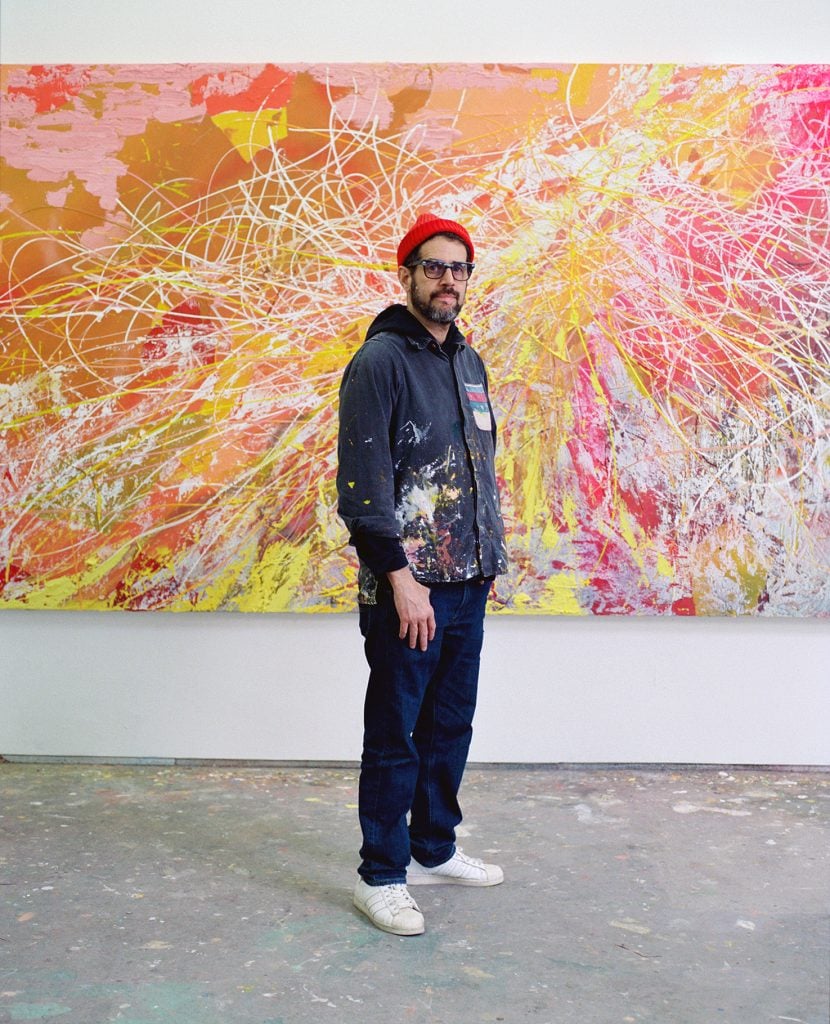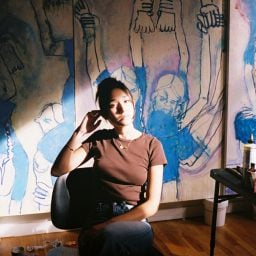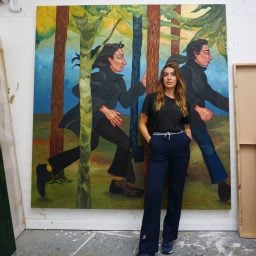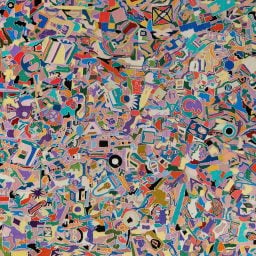For Cuban-born artist José Parlá, sunlight and music are the foundations of a good studio practice. The artist who has lived and worked in Brooklyn for 27 years found his current studio—a classic industrial warehouse space—over a decade ago while riding his bicycle around the downtown area.
Renovated by architectural firm Snøhetta, the studio today is a sprawling, light-filled creative space with a full kitchen, a library, and areas devoted to listening and playing records. Over the past year, Parlá has split his time between this studio and Miami, where he grew up, preparing new work for his upcoming exhibition “Phosphene” at Ben Brown Fine Arts in London (October 11—November 17, 2023).
“Phosphene” is the second installment of a two-part exhibition; the first installment opened at the gallery’s Hong Kong space in March of this year. The title refers to the experience of seeing light through closed eyes—colorful flashes or swirling dots appearing on the eyelid. Filled with motion, color, and brimming energy, the paintings are Parlá’s personal reflections on his near-death experience with COVID-19 in 2021. Compositionally, the monumental works hint at the inner workings of optical nerves, or, with their rhythmic gestures, a kind of synesthesia.
Ahead of the exhibition opening, we caught up with Parlá in his downtown studio to talk about the exhibitions that have dazzled him lately as well as his lesser-known ceramic works.
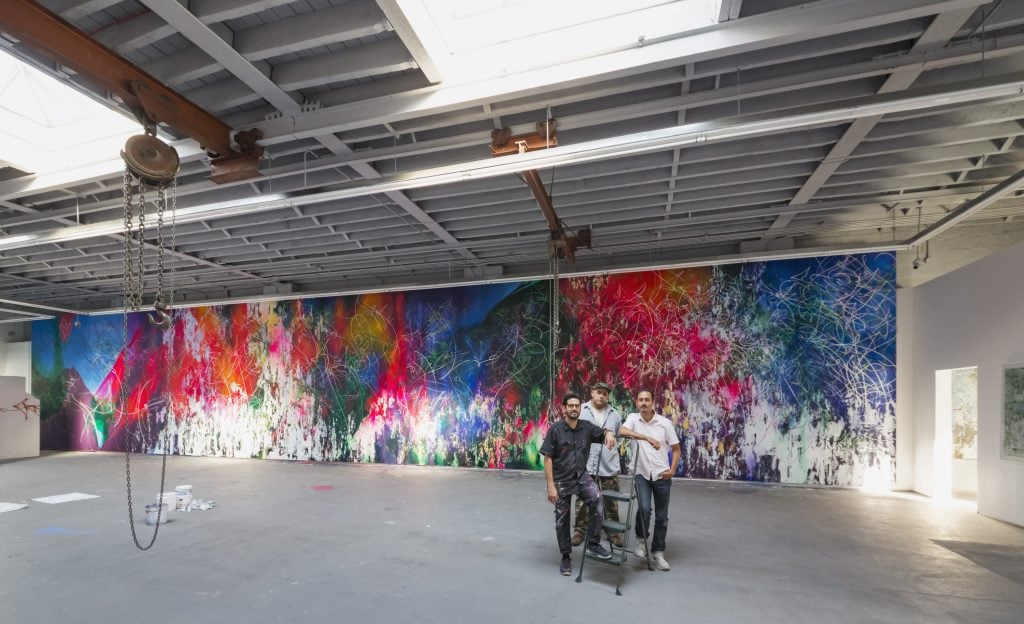
José Parlá, Christian Mendoza and Rey Parlá. Image © Jeff Goldberg/ESTO
Tell us about your studio. Where is it, how did you find it, what kind of space is it, etc.?
My studio is in Downtown Brooklyn, New York. I found it riding my bike around the neighborhood one afternoon. I was searching for a new place to make large-scale paintings and installations. I had recently been awarded the commission for my painting One Union of the Senses, which has been permanently installed at the entrance of One World Trade Center in Manhattan since 2015. I’ve been in Brooklyn now for 27 years and this current studio for 10 years, so it was great to stay nearby and in my own community that I love.
The space is a classic industrial warehouse that we overhauled in collaboration with architecture and design firm Snøhetta and my brother Rey Parlá. It has a small reception area with a full kitchen and seating at the entrance. The main space opens up with movable walls into the main painting arena and there is a large storage area in the back, also with movable walls. The mezzanine area looks into the main studio. We call that “the nest.” There we can brainstorm in the library, play music, and have meetings. Lots of inspiration in this space.
What made you choose this particular studio over others?
The location and potential I saw to fully renovate it to our needs.
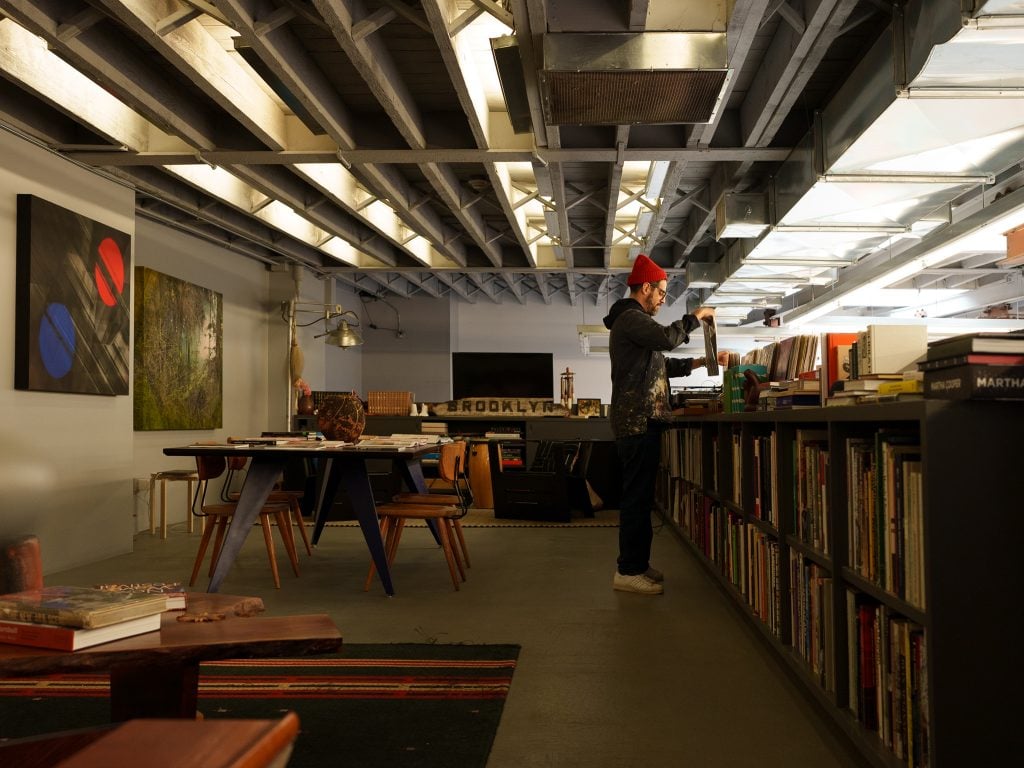
José Parlá in his studio, 2023. Photo credit Tyler Haft
How many hours do you typically spend in the studio, what time of day do you feel most productive, and what activities fill the majority of that time?
I like being in the studio by 8:30 a.m. and feel most productive absorbing the natural daylight painting in the main space. For my Phosphene series, for which an exhibition of new paintings opens on October 10 at Ben Brown Fine Arts, London, I would use the sun to see colors differently. I would look quickly at the sunlight, blink my eyes, and close them to capture the phosphene spots of lights and colors in my memory. Directly from that I would mix paints to create unique colors and marks to use in the layers of the paintings. The sunlight moves clockwise in my studio so I can tell the approximate time by its movement and the way the sun lights the paintings as it changes position, so I sometimes change and follow the sun as well.
What is the first thing you do when you walk into your studio (after turning on the lights)?
Every day is different, but I love to make coffee, put on some music, and absorb the work in progress going on with my paintings before anything else. I catch up with the team about what has to get done each day and then get to work on the paintings.
What kind of atmosphere do you prefer when you work? Is there anything you like to listen to/watch/read/look at etc. while in the studio for inspiration or as ambient culture?
Part of my studio practice and inspiration comes from music, so there is often music playing and an atmosphere that provides the rhythm of the studio. It gets busy when you have exhibitions coming up and the photography, shipping, and packing stage starts to happen so I like it to keep things festive, so everyone on the team and visitors also enjoy being in the studio. Sometimes I cook Cuban food as well so there’s always this kind of energy. Every day is different, sometimes I am in a quiet mood and paint alone for hours into the night.
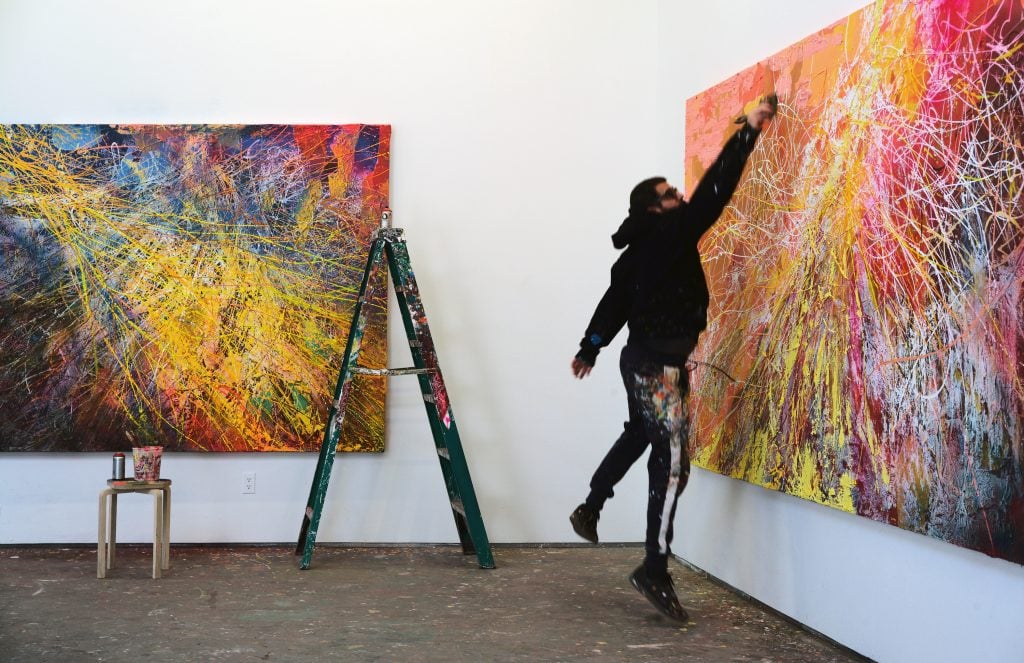
José Parlá painting Seeing is Believing. Photo credit Farzad Owrang
How do you know when an artwork you are working on is clicking?
Something personal clicks that are difficult to explain but I just know when I am done with a painting. It happens that close friends or a gallery will say, “Wow that’s amazing, is it finished?” And I can see things missing that no one else can see. It’s intuitive and random but I just know I have to keep working until I get to completion. The journey is not always easy. It can be challenging when I am trying out new materials or colors, and when something actually works and feels right, it is a gift. I feel good about that.
What’s the last museum exhibition or gallery show you saw that really affected you and why?
There are so many museum exhibitions that have affected me in different ways. The Pepón Osorio exhibition at the New Museum really resonated with me in ways that connected me to my youth and education living in Puerto Rico as a kid and being from Cuban parents. Cuba and Puerto Rico share many similarities and there was this feeling in me of nostalgia and anxiety. The humming sound in part of the exhibition, the murder installation in “The Scene of the Crime” was really intense but also had so much religious and cultural symbolism I am familiar with. It was strangely beautiful and shocking at once.
Recently I was in Buffalo, New York, to visit my friend Futura who is exhibiting at the University of Buffalo Art Galleries. Futura is an artist who has also been a mentor to me and many of my generation. Through hip-hop and the years of traveling in Japan and Europe and being part of a large family of artists, it was mind-blowing to see so much of his work in one place. The exhibition was very well organized, showing his early paintings, sketchbooks, and objects from the 1980s in one space, explaining the culture visually, and in a separate space, his influence through collaborations is exhibited. He has been interested in this for years and paving the way for how many artists now operate collaborations in fashion, music and street culture. And in another space, Futura’s newest paintings made specifically for Buffalo were shown.
While in Buffalo I went to see the Buffalo AKG Museum, previously known as the Albright Knox. They recently overhauled and expanded the museum with the OMA design and architecture firm. It’s really beautiful. I’m honored to be in their collection. The very significant exhibit of over 33 paintings by Clyfford Still was mind-blowing. The paintings on their own have such arresting power and the way the exhibition was laid out with books and chronological wall texts really allowed me to see clearly the artistic and personal challenges and integrity of the painter.
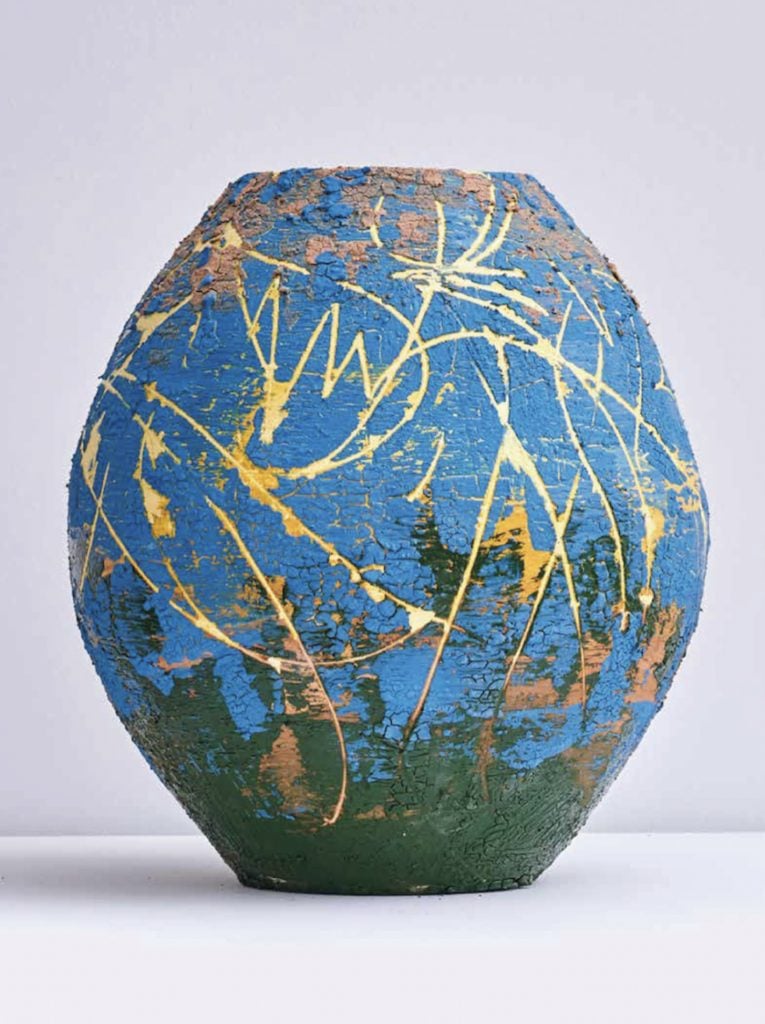
Courtesy Parlá Studios
Where do you get your food from, or what do you eat when you get hungry in the studio?
We have a couple of lists of groceries we buy every week and cook at the studio most days. If we have a lot of people working on a photo shoot sometimes we order pizza or if there is time I cook Cuban food.
Is there anything in your studio that a visitor might find surprising?
Visitors are always surprised on their first visit to the studio because of the architecture and large-scale paintings, but I think people are really surprised when they see my ceramics as I am not as known for making ceramics.
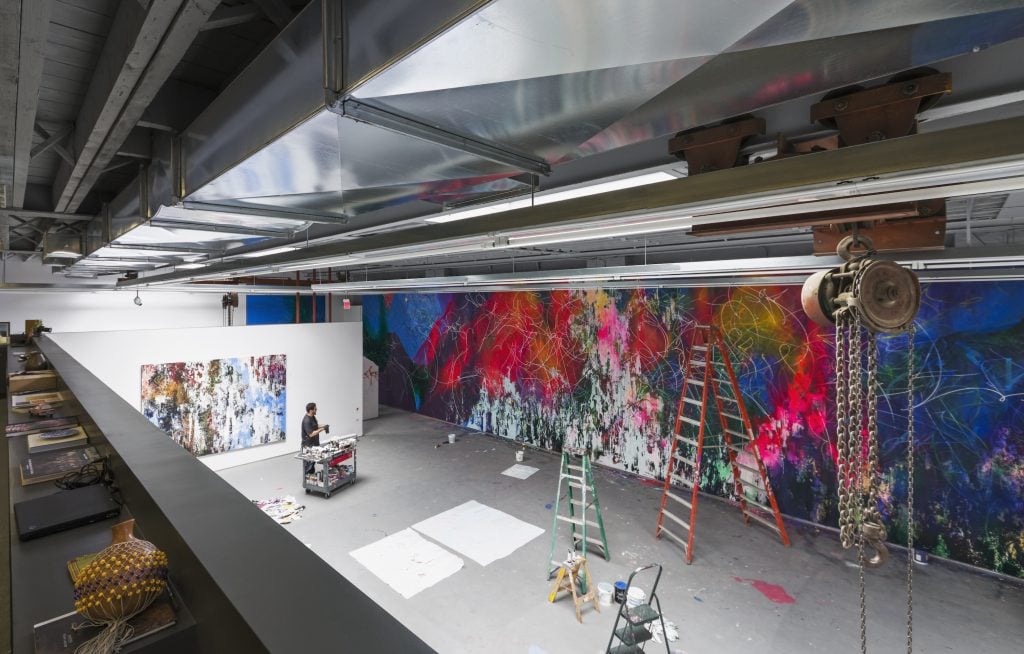
Jose Parla Studio, Location: Brooklyn, New York, Architect: Snohetta
How does your studio environment influence the way you work?
The sunlight throughout the day is a blessing. Playing music, eating well, being organized, all of these little things help to stay focused and energized. I am extremely grateful to my brother Rey and our friend Christian, to our community of close friends who have been supportive during the most difficult times during the pandemic. I like to think the environment in the studio is healthy because of what happens outside in the world for us. I would have a massive list of people to list here to express my deep gratitude for all who support our studio practice. Family, friends, collectors, galleries, museums, and all the people who work in these spaces.
What’s the last thing you do before you leave the studio at the end of the day?
The very last thing I do is put on the alarm.
